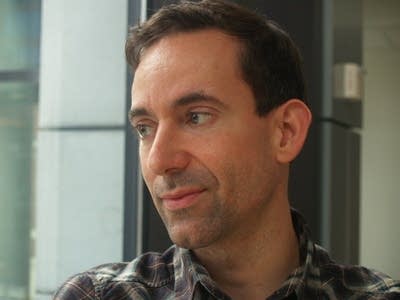Craig Thompson's complex intertwinings in 'Habibi'
Go Deeper.
Create an account or log in to save stories.
Like this?
Thanks for liking this story! We have added it to a list of your favorite stories.

Graphic artist Craig Thompson believes that comic-books have yet to reach their full audience. His latest graphic novel 'Habibi' is an epic tale of love between two orphans in an un-named desert, and it draws on a huge array of religious and artistic traditions.
Thompson grew up in small town Wisconsin in a strictly religious family, but moved as a young man to Portland. These experiences underlie his work, he said.
"I think most people can connect with this sense of being an outsider and losing your sense of home," he said. "I think it's a theme in all my books and I think its a theme of most art, is this longing for something that you lost, perhaps before your were born."
Thompson will speak about his work in Minneapolis Monday evening.
Turn Up Your Support
MPR News helps you turn down the noise and build shared understanding. Turn up your support for this public resource and keep trusted journalism accessible to all.
'Habibi' is a large book, 672 pages of intricately illustrated story.
The story is set in a Middle Eastern desert, which may be in ancient times or it may be today. It tells about Dodola, a girl who was sold by her family for marriage to a man they don't know. When she escapes she meets Zam, an orphan. They live in an abandoned boat, stranded in the dunes.
It took Thompson seven years to research, write, illustrate, edit and finally publish 'Habibi."

"The book is like a mash-up of the sacred medium of the holy books, like the Koran and the Bible, mixed up with the vulgar story of pulp medium of comic books, which would have been my two biggest influences growing up, the Bible and comic-books," Thompson said.
"And then there is a nod to "1,001 Nights" and this sort of theme of Sheherezade telling stories for survival, and one story folding in on an other, so that you lose track of where you began."
Thompson also makes use of the magic squares designed by Arab mystics, who found meaning in the shapes, designs and even narratives in numeric patterns.
"It's basically mystical sudoku," he says. "Sudoku has its own narrative, it's a mathematical narrative, and I exploited that for the sake of the book."

Habibi is a complex interweaving of the sacred and the profane, touching on themes of power and politics, human trafficking, environmental exploitation and the joys and sadnesses of love. Critics have raved about its beauty.
Thompson said he's encouraged by who seems to the attracted audience for the book.
"I have always had this theory that comics can reach a broader audience, and it's been held back for many years by a lot of the attitudes by this sort of cliquish comics industry, but that it's a medium that has this potential to be very accessible," he said. "And I'm finding that already in this first week of the tour is all ages, definitely both sexes, people of different religious beliefs, lots of Muslim readers are coming out to signings."
Thompson will speak about the book tonight at 7 p.m. at an event at the Minneapolis College of Art and Design sponsored by the Rain Taxi Review of Books. MCAD has a popular comics design course in its curriculum.
Thompson will discuss his process, and how a group of expert friends were able to advise him on things such as the correct use of Arabic script. They helped him avoid cultural minefields such as depictions of the Prophet Mohammed, which have cause worldwide outcry in the past.
"With for instance the Danish cartoon controversy so many of those cartoons were meant to be deliberately provocative, even insulting," Thompson said. "But I think if you are coming from a more pure intent, my friends were able to able recognize the reverence and respect in the depiction of Mohammed. And also I was drawing from the tradition in Persian miniature paintings of showing the Prophet Mohammed with a cloaked face."
Asked how this work has changed him, Thompson said scientists say all the cells in the human body are replaced over seven years, so of course he has changed. He now sees things in circular patterns: did the new Craig Thompson change the book, or did the book change him?
And that circularity, he said, is part of the charm of the story.



